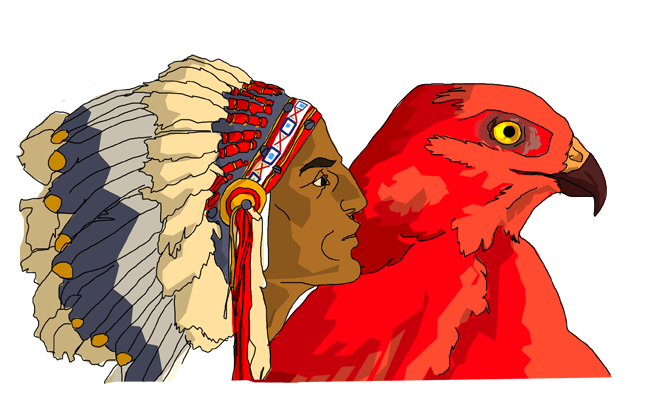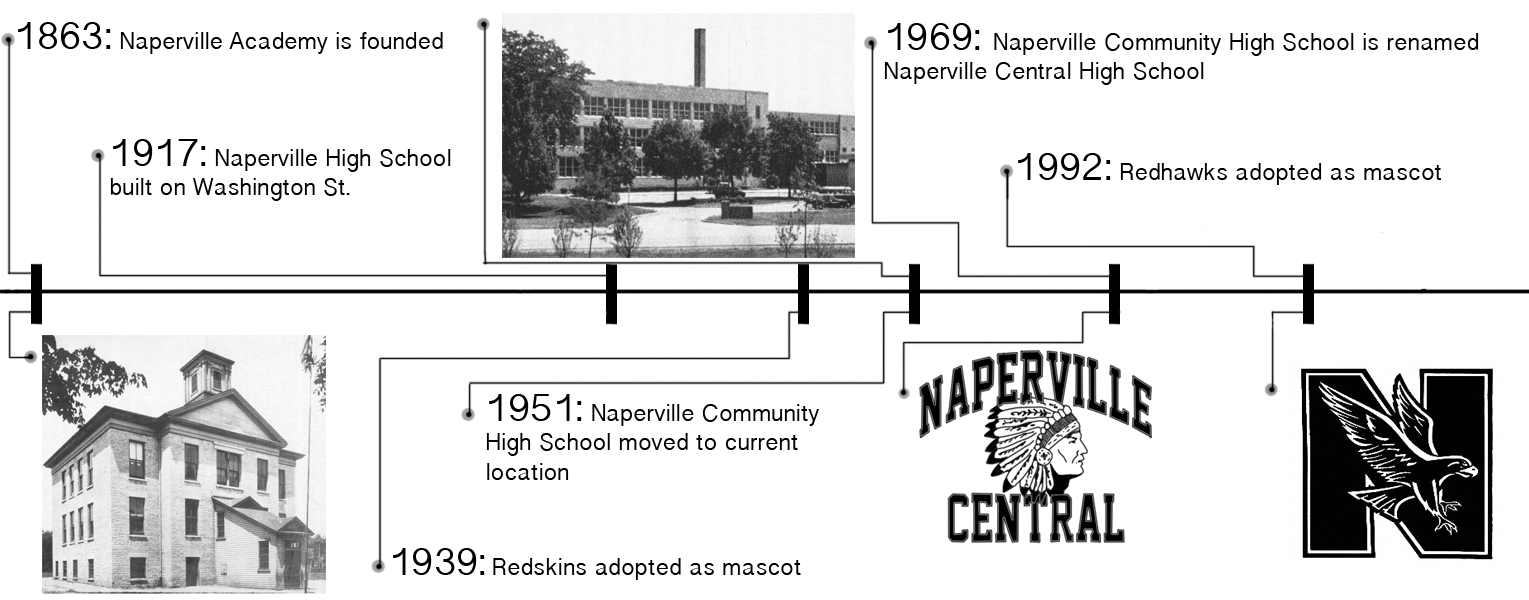Fight or Flight
A look back at Central’s mascot change puts recent national events regarding Native American appropriation into perspective

At Naperville Central’s athletic entrance, visitors are greeted by the mosaic of a Native American’s profile dressed in traditional headdress. A mural of a group of Native Americans surrounding a teepee hangs on a wall in the Student Activities office. Both are reminders of Central’s history—a history that many of us may not even know about—of a time more than 20 years ago when the school’s nickname and mascot was the Redskin.
Two recent news events—coupled with Central’s Homecoming—make this a good time to revisit the past. The first is the trademark cancellation of the Washington Redskins by the U.S. Patent and Trademark Office on the basis that it is “disparaging to Native Americans.” The second story, which we will examine here, deals with the events surrounding a Pennsylvania high school newspaper that decided not to publish the term Redskins, the school mascot, in the paper.
A Central history lesson
Since 1939, Naperville High School’s mascot has been the Redskins. With many generations having grown up identifying the school with this symbol, the change was not an easy one. In 1991, then principal Tom Paulsen received a call from a member of the community explaining her concern over the use of Redskins as a school mascot.
“She was not nasty about it or demanding, she just thought that we should think this through,” Paulsen said. “So we did start to talk, internally, in late 1991.”
Paulsen brought in local Native Americans to Central to speak with the student government. Central students explained how they associated honor and respect to Native Americans with their mascot. The visitors counter-argued that the opposing teams may not have the same opinions and may depict Native Americans in a derogatory way. Though Paulsen at that time decided Central would not change the mascot, he viewed this as a learning opportunity for the students.
“We made the determination that we were not going to recommend any kind of change [to our mascot] moving forward and we were going to stay with the name, but we were going to try to make some changes that would make sure that we did not show the Native American figure in a cartoon fashion,” Paulsen said. “We would use the name as a basis for educating our students more fully about Native Americans.”
According to Paulsen, these same Native Americans brought forth the issue to the school board, where no immediate action was taken. The topic came up in many subsequent school board meetings.
James Kreamer, the school board president in 1991-1992, was not in favor of changing the mascot. He has always believed in the pride and honor of the Redskin name.
“I have four children, and they spent a total of 31 years between them on athletic teams at Central,” Kreamer said. “Like all athletes in my opinion, like all athletes at Central [and] every member of the marching band at Central, they didn’t look upon Redskins as a derogatory name, they looked at it as wearing the uniform with honor.”
Others agreed with the Native American point of view, that the name should be changed due to its offensive nature. Jean Johnson, a student at the time, learned this lesson from her volleyball coach and sided with the Native Americans on the issue as a high school student.
“My coach told me a story how, over the summer break, he and his family had gone out West and stopped at an Indian reservation to do laundry, and he was wearing a Naperville Central sweatshirt with the Redskins mascot on it,” Johnson said. “He visibly noticed people seeing the sweatshirt and reacting in a negative way. Not in an angry way, but more hurt and disappointed. He told me that [Redskins] really has a negative connotation and it’s offensive to an entire culture of people.”
Health teacher Ruth Kuzmanic was a staff member in 1992 and was passionate for the change.
“Words set up your relationship with that person and if you’re treating any class of people as lesser, it kind of degrades yourself,” Kuzmanic said. “Any kind of derogatory language [like Redskins] lessens the climate of the culture and our school’s culture. Everybody is welcome, and we’re not a welcoming place if you’re going to use those kinds of words.”
A large number of people wanted to express their opinions on the issue, causing the school board to move its next meeting to Central’s cafeteria. Many more meetings followed. According to social studies teacher Jane Thompson, also a faculty member in 1992, these meetings would get heated.
“The school board meetings were very contentious,” Thompson said. “[They] got very personal with the name calling and it went through a year’s turmoil. Eventually, the school board made a decision to change the name.”
Redskins no more
In June 1992, at his last meeting with the school board, Superintendent James Clarke decided to bring the issue to a final decision and have the board vote on it. He recommended that the school board establish a policy that no mascot should be offensive to any group and drop the Redskin. According to Kreamer, the final vote was 5-2 to change the mascot.
Incoming Superintendent Donald Weber was tasked with writing new district guidelines for school mascots, but the fight continued when 10 members of the community filed a lawsuit stating that the school district had no right to change the mascot because it was historical and traditional. Paulsen explains that the judge determined that the school board did have the right to make this decision.
At the school level, Central looked for a new mascot. There was an assembly where student-created ideas for mascots were shown and discussed. The final decision came down to a vote, where Redhawks beat out other options like the Scarlet Knights and Razorbacks, though Paulsen said “it was definitely a plurality, not a majority by any stretch of the imagination.”
The advantage of the Redhawk is that it main tained the word red in the title, and John Perry, who was the assistant athletic director and an art teacher at the time, created a logo maintaining the N and replacing the Native American head with a diving hawk.
According to Thompson, after two or three years, the animosity passed.
“Eventually, you knew over time a new mascot was going to be embraced, it would just take a generation of students to get that full ownership out of the Redhawk itself,” Thompson said. “It was the retiring of an old tradition and the bringing up of the new.”
Same controversy, different state
In Langhorne, Pa., Neshaminy High School’s student-run newspaper, the Playwickian, came to a majority decision in October 2013 refusing to publish the name of their school’s mascot, the Redskin, in its monthly issues.
“We got together as a group of editors and decided that we wouldn’t publish it because we deemed it to be a racist term,” said Reed Hennessy, current co-editor in chief of the Playwickian. “All 21 of us took a vote and it was 14 to 7; I was one of 14.”
The student and community reaction to this editorial decision has been as heated as the debate at Central in the 90s, but school authorities in Pennsylvania have added fuel to the fire. Robert McGee, the principal of Neshaminy High School, told the Playwickian staff members that they did not have the authority in making that decision but the staff felt strongly that it was making the correct choice, protecting its First Amendment right of freedom of the press and fighting for respect of Native Americans.
The school board got involved too, and conversations to rewrite Policy 600—which deals with Neshaminy School District publications—started. Since 1967, the policy has been a mere six lines long, but with the new revisions proposed in late April, the policy inflated to eight pages. The revised policy, approved in June of this year, increases the principal’s “prior approval” period from three days to 10, prohibits students from censoring the word Redskin and puts the electronic publication of the Playwickian under the district website where “likes” and comments are not allowed. When referring to the school mascot, Policy 600 states that “the term shall not be construed as a racial or ethnic slur and is not intended by the Board of School Directors as a racial or ethnic slur.” The newspaper staff considers the school board decision to be a step backward.
“The entire policy is based around two concepts: one is to protect the mascot and two is to punish the Playwickian by hindering the whole educational process that goes into making a newspaper,” Hennessy said.
More restrictions were placed on the paper after an incident in June. When a letter to the editor was sent to the staff with the word Redskins used multiple times, the Playwickian decided to publish it using “R——-” instead of the full word. McGee instructed the newspaper to publish the letter to the editor with the complete word, but the editors decided to publish the newspaper with a note that read: “this white space represents our resolve to maintain our rights as editors and our determination to eliminate discrimination.”
This lead to a two-day suspension without pay for the newspaper’s adviser, a 30-day suspension of Gillian McGoldrick’s duties as editor in chief and confiscation of all June issues of the Playwickian.
“I didn’t care about taking the fault for it, but the problem I have with this is that my adviser got suspended for two days without pay,” said McGoldrick, who is co-editor in chief for this school year. “It is awful because she got suspended for something that we, the students, did.”
There is currently no push at Neshaminy High School to change the mascot; in fact, when Playwickian staff members wrote the editorial stating their choice, the response from students was not positive. After a year, the staff members have received more support from their classmates.
“At the beginning of last [school] year—November and December—when we were distributing newspapers people would rip them to shreds and light them on fire,” McGoldrick said. “Over time, people have been realizing that our rights are being infringed on. I saw a couple people say [that it was] awesome that we were standing up for something. It was really cool to finally get that from my peers.”
Hennessy explains that there is a lot of tradition and pride with the Neshaminy High School mascot, making it hard for current students, alumni and community members to let go of it. This is not much different from Naperville Central’s history, where students and alumni fought to keep Redskins as the mascot.
“We had just been with it for years, our older brothers and sisters had been with it for years, we were just the Redskins and that’s the way we were,” said Sara Lueken, a 1992 graduate of Central. “We had pride. We had pride in our name.”
Over the years, Paulsen has reflected on what happened 22 years ago. He understands that students and alumni are proud of the high school they attended, and how this pride remains even after the changing of the mascot. However, he believes that school pride should not be at the expense of other groups and their cultural identities.
“Why should we be offending people with our mascots and our symbols?” Paulsen said. “Who am I to say it’s not offensive to them? I’m not Native American, they’re Native Americans. They’re offended by it, and for me to say you shouldn’t be doesn’t make any sense and isn’t really fair to them.”

Your donation will support the student journalists of the Central Times by helping to fund publication expenditures.

Favorite quote: "Nothing is impossible, the word itself says 'I'm Possible'!"- Audrey Hepburn
Best memory at Central: Performing at the Homecoming and Winter assemblies with Orchesis Dance Team
A word that describes me is: Energetic
My interest in journalism is: Profiles! I love interviewing people

“The difference between the almost right word and the right word is really a large matter—it's the difference between the lightning bug and the lightning.” - Mark Twain
Contact Information:
[email protected]


